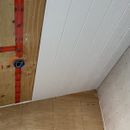Prime/paint plywood cathedral ceiling before installing painted shiplap? Critique my air sealing methods too- pic within
I’ve got a cathedral ceiling with 23/32 plywood inner layer that is currently unfinished. Is there any benefit to priming and or painting the (airsealed) plywood before installing painted T&G directly to it?
1. Will priming painting the plywood ceiling create a form of a “vapor barrier sandwhich” and create mold issues between the painted plywood ceiling layer and the T&G?
2. Or will priming and or painting the plywood be beneficial and allow less moisture into my cathedral ceiling?
-if it matters- Rockwool r30 insulation above the plywood, followed by site built semi-permeable insulation baffles with 1.5” air gap above. Located in San Diego. Mild climate.
the boards in this pic are samples only.
While I’ve got you- feel free to critique my airsealing methods.
-perimeter layer of all wall/ceiling plywood has bead of quadmax between framing and edge of plywood
-plywood panels all gapped 1/8-3/32”. All in the field seams filled with quad max sealant and then covered with red tuck tape.
– wall to ceiling joints filled with fire block foam then covered with quad max sealant.
– light box- all penetrations sealed. Spray foamed to plywood.
Look ok?
GBA Detail Library
A collection of one thousand construction details organized by climate and house part










Replies
Buildingfun,
Un-coated plywood works very well as a variable perm vapour-retarder. When dry it is under 1 perm, so there is no real benefit to painting it. What you have done looks good.
Malcom Taylor- doesn’t the perm rating of plywood change a lot when damp though? Say you’re boiling water for an hour on the stove below this cathedral ceiling….
Excess vapor/ moisture makes its way past the the T&G and now makes the inner surface of the unfinished plywood damp. Doesn’t that moisture essentially just wick its way up and through the plywood? Ie: doesn’t the plywood act more like a sponge than a vapor barrier once the surface gets moist?
For the record- I’m not doubting your reply at all. As much as I’m looking for the answer, I’m even more interested in learning the “rules” and concepts and how different materials work.
Or maybe this is just confusing me like “smart vapor barriers” do. They too seem to work great as a barrier until wet (lots of vapor) in which case they let moisture though. Still trying to figure out how that’s “smart”. To me it just sounds like a piece of wood which stops vapor till it doesn’t.
Buildinfun,
The interior air should never be humid enough (in a kitchen or elsewhere) to open up a variable-perm retarder enough to cause an appreciable amount of moisture to move into the wall or ceiling. They are there to allow the assemblies to dry in both directions when they have excess moisture.
So you keep the house at a reasonable level of RH through ventilation, not using the building assemblies as a way of exhausting excess moisture. And if the assemblies experience excess moisture, you allow them to dry to the interior through the variable perm vapour-retarder.
Thanks!
That makes sense when considering moisture that would/wouldn’t be allowed into the ceiling cavity.
What about mold/mildew/moisture trapped between the ceiling layers? Any chance of moisture between the plywood and the painted T&G? At first I was thinking a quick coat of 123 Primer would be a good "just in case" measure to prevent any mold on the plywood and prevent the plywood from absorbing humidity from boiling water, but now I'm wondering if the plywood would actually dry better uncoated?
Thanks again for the reply
Edit- forgot to mention, this will be a kitchen which is why I’m so worried about humidity from boiling water, cooking, dishwasher, etc.
You shouldn't have an issue between ceiling layers where those layers are permeable materials like wood. Wood isn't a vapor barrier. Where you could potentially have problems is if, for example, you had a layer of foil faced polyiso, then some plywood, then some fluffy batts, then a layer of polyethylene, then your T+G. The foil facing on the polyiso and the polyethylene are both vapor BARRIERS, and the batts would be an area where moisture could potentially accumulate over time and cause problems.
In your case, you don't have have vapor barrier materials, so moisture can get out, and you don't have anywhere for the moisture to accumulate between plywood and the T+G, since there isn't really much of an air space there. You also have a vented roof assembly, which helps to prevent the buildup of moisture too. You should be in pretty good shape.
If you are worried about future mold issues, and I don't think you need to be here, Zinsser -- the same people make 123 primer -- also make a "mold killing primer". You could prime the plywood with that mold killing primer as some extra insurance against future mold problems. I've used that primer before on attic sheathing after removing mold as some insurance against future mold growth after also fixing whatever was the cause of the mold in the first place (typically a leaky ceiling).
BTW, don't forget to air seal inside that blue plastic electric box. Those boxes usually have various screw holes and gaps around the cable clips that can leak. I like to use red silicone high temperature caulk (NOT intumescent fire stop caulk!) for this purpose. Just smear on a SMALL amount to make a THIN layer over any holes/gaps in the box to get a good air seal.
Bill
I like your idea of silicone. I find normal caulk gets too hard and annoying to deal with later.
I think your painted T&G is a very nice looking finish.
Thanks